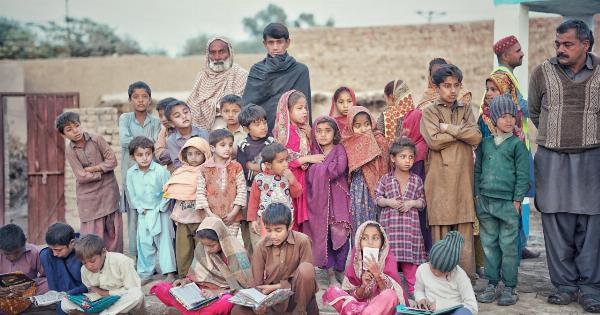Menstruation is a natural process experienced by girls and women around the world.
However, in many developing countries, it is accompanied by cultural taboos, lack of access to sanitary products, and limited knowledge about menstrual hygiene management. This leads to numerous negative consequences, particularly with regards to girls’ education. In this article, we will explore the detrimental impact of periods on girls’ education and discuss potential solutions to address this issue.
1. School Absenteeism
One of the primary impacts of periods on girls’ education is increased absenteeism from school.
Many girls in developing countries do not have access to proper menstrual hygiene products, making it difficult for them to manage their periods hygienically. As a result, they often stay at home during their menstruation, missing several days of school each month. This constant absence disrupts their learning and puts them at a disadvantage compared to their male peers.
2. Limited Academic Performance
When girls miss school due to their periods, they miss out on essential academic content and fall behind their classmates. This continual absence can negatively impact their overall academic performance, making it harder for them to catch up.
Consequently, girls who are unable to manage their periods effectively may suffer from lower grades and reduced educational opportunities.
3. Stigma and Shame
In many cultures, menstruation is associated with shame and embarrassment. Girls often face stigma and teasing from classmates and teachers during their periods, which can lead to a decreased sense of worth and self-esteem.
The fear of being ridiculed or humiliated may further discourage girls from attending school during menstruation, perpetuating a cycle of reduced educational participation and achievement.
4. Lack of Access to Sanitary Facilities
Inadequate access to clean and private toilets and washing facilities in schools exacerbates the challenges faced by girls during their periods. Without suitable infrastructure, girls may feel uncomfortable and exposed while changing sanitary products.
The lack of proper sanitation facilities also increases the risk of infection and further adds to the stigma surrounding menstruation.
5. Limited Information and Support
Many girls in developing countries lack access to accurate information about menstruation and proper menstrual hygiene management. This lack of knowledge can lead to misconceptions and improper practices, further impacting their health and education.
Additionally, the absence of comprehensive sexual and reproductive health education hinders girls’ understanding of their bodies and rights, perpetuating harmful social norms and taboos surrounding menstruation.
6. Economic Constraints
The financial burden of purchasing menstrual hygiene products can be significant for girls and their families, particularly in impoverished communities.
The cost of sanitary pads or tampons often exceeds the available budget, forcing girls to resort to unhygienic alternatives such as old rags or improvised materials. This not only compromises their health but also affects their education, as financial constraints limit their ability to remain in school during their periods.
7. Early Marriage and Dropout Rates
Girls who face challenges related to menstruation are more susceptible to societal pressures and expectations. In some cultures, menstruation is seen as a sign of maturity, leading to early marriage and subsequent dropout from school.
When girls are forced into marriage at a young age, their educational journey is abruptly halted, depriving them of the opportunity to achieve their full potential.
8. Lack of Policy and Advocacy
The issue of menstruation and its impact on girls’ education is often overlooked or neglected by policymakers and educational institutions.
Insufficient policies and guidelines for addressing menstrual health and hygiene in schools leave girls unsupported and without necessary resources. Additionally, limited advocacy efforts further perpetuate the silence surrounding this critical issue, hindering progress towards inclusive and equitable education for all.
9. Mental Health and Well-being
The negative impact of periods on girls’ education extends beyond academic barriers. Menstruation-related challenges can take a toll on girls’ mental health and overall well-being.
Dealing with the physical discomfort, shame, and anxiety associated with periods contributes to increased stress levels and diminished motivation to participate fully in educational activities.
10. Breaking the Cycle
Efforts to address the negative impact of periods on girls’ education must focus on multiple levels. Firstly, comprehensive sexual and reproductive health education should be integrated into school curricula.
This education should aim to dismantle taboos, debunk myths, and provide accurate information about menstruation and menstrual hygiene management.
Secondly, schools and communities must prioritize the construction of clean and private sanitation facilities, including toilets and handwashing stations.
These measures not only enable girls to manage their periods hygienically but also promote their overall health and well-being.
Thirdly, there is a need for affordable and accessible menstrual hygiene products, such as reusable pads or subsidised sanitary products, to ensure that girls can manage their periods without hindrance.
Collaborative efforts from governments, NGOs, and private sectors are required to make these products widely available.
Lastly, raising awareness and advocating for policy changes to address the negative impact of periods on girls’ education is crucial.
Governments and educational institutions should recognize the significance of this issue and allocate resources to support menstrual health and hygiene programs in schools.
By breaking the silence surrounding menstruation, promoting menstrual equity, and providing necessary resources, we can create an environment where all girls have equal opportunities to education, unhindered by the challenges associated with their periods.





























